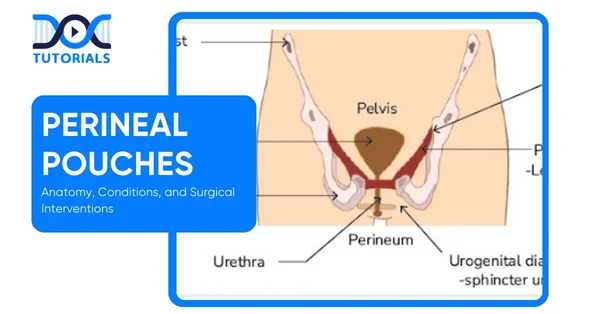Perineal Pouches: Anatomy, Conditions, and Surgical Interventions

The perineum, a seemingly insignificant but intricate area of the body, is a vital region for urinary, reproductive, and intestinal functions. It is located between the thighs and runs from the pubic symphysis to the coccyx and contains the perineal pouches—superficial and deep spaces where vital muscles, vessels, and nerves are located.
For medical students studying for the NEET PG exam, having a proficiency in the concept of the perineal body, its anatomy, structure, etc., is a must. It is a functional centre that affects urination, defecation, sex, and childbirth.
Keep reading to understand the complex facts, clinical significance, and surgical considerations for perineal pouches.
What are Perineal Pouches?
The perineal pouches are potential spaces in the perineum below the pelvic diaphragm. They are classified as 2 pouches, i.e., the superficial perineal pouch and deep perineal pouch. The superficial perineal pouch comprises glands, muscles, and erectile tissues.
On the other hand, the deep perineal pouch contains the external urethral sphincter, the urethra, and associated muscles. The perineal body holds these compartments against the lateral pubic arches.
What is the Anatomy of Perineal Pouches?
The perineal pouches are anatomical spaces of the perineum, separated into superficial and deep perineal pouches by a thick, dense fibrous layer known as the perineal membrane. They are important spaces that support the pelvic organs, contain muscles, neurovascular elements, and erectile structures, and preserve urinary and reproductive functions.
The anatomy of perineal pouches comprises the following:
- Superficial Perineal Pouch
The superficial perineal pouch lies between the perineal membrane and superficial fascia (Colles’ fascia). The key functions of the superficial perineal pouch include the support of erectile tissues, supporting urinary and sexual function.
- Parts in Males: Root of penis (bulb and crura), bulbospongiosus, ischiocavernosus, and superficial transverse perineal muscles; proximal spongy urethra; branches of the internal pudendal vessels and pudendal nerve.
- Parts in Females: Clitoris, vestibular bulbs, Bartholin’s (greater vestibular) glands, bulbospongiosus, ischiocavernosus, and superficial transverse perineal muscles.
- Deep Perineal Pouch
Lying above the perineal membrane and below the pelvic diaphragm, the deep perineal pouch houses important muscles and structures vital for urinary continence and pelvic support.
- Parts in Men: Deep transverse perineal muscles, membranous urethra, external urethral sphincter, and bulbourethral glands.
- Parts in Women: Proximal urethra, vagina, external urethral sphincter, urethrovaginalis muscle, and transverse deep perineal muscles.
- Perineal Body
The perineal body is an intermediate fibromuscular mass situated at the intersection of the urogenital triangle and the anal triangle. Its major functions are:
- Serves as a meeting point for different muscles, including the bulbospongiosus, superficial and deep transverse perineal muscles, external anal sphincter, and levator ani muscles.
- It offers structural support to both the superficial and the deep perineal pouches and plays an important role in maintaining the proper function of the pelvic floor.
What are the Functions of Perineal Pouches?
Superficial and deep perineal pouches, which are suspended around the perineal body and urogenital diaphragm, constitute a functional and structural network providing support to pelvic organs, ensuring continence, and aiding sexual and reproductive function. The key functions of perineal pouches are as follows:
- It provides structural support to the urogenital organs.
- It holds erectile tissue for both genders and supports sexual function.
- It holds muscles like the external urethral sphincter, which are used for voluntary urination.
- It protects important blood vessels and nerves, which supply the perineal and pelvic regions.
What are the Disorders or Complications Associated with Perineal Pouches?
Here are the common diseases and disorders associated with the perineal pouches:
- Bartholin’s Cyst: A Bartholin’s cyst develops when the duct of the greater vestibular gland in the superficial pouch becomes obstructed, resulting in fluid build-up. If it becomes infected, an abscess may develop.
- Pelvic Floor Dysfunction: Weakness in the muscles of the deep pouch, including the external urethral sphincter, may cause urinary incontinence.
- Erectile Dysfunction: In males, damage to the nerves or blood vessels in the superficial pouch can lead to erectile dysfunction.
- Tumours: Tumours like perineal lipomas or carcinomas can invade the structures within the perineal pouches. Early detection is essential for effective management.
What are the Surgical Interventions to Treat Problems Associated with Perineal Pouches?
Here is a comprehensive list of surgeries conducted to treat various problems related to perineal pouches:
- Treatment of complications resulting from tumour removal
- Fistula management or pelvic floor reconstruction
- Perineal colostomy
- Perineoplasty
- Pouch reconstruction and excision
- Pouch salvage surgery
- Proctocolectomy
- Episiotomy
FAQs about Perineal Pouches
- What are the boundaries of the perineal pouch?
The perineal pouch is bounded superiorly by the perineal membrane and inferiorly by the superficial perineal fascia (Colles’ fascia). Colles’ fascia attaches posteriorly to the perineal membrane, laterally to the pubic arch, and continues anteriorly with Scarpa’s fascia of the abdominal wall.
- What muscles are found in the deep perineal pouch?
The deep perineal pouch has the deep transverse perineal muscles and the external urethral sphincter (both in males and females). It also accommodates the membranous urethra in males, the proximal urethra in females, and the bulbourethral glands in males.
- How can perineal infections be prevented?
Practice perineal hygiene by washing the area after each visit to the toilet and drying it gently. Always wipe from front to back to avoid contamination from the anal area, and change sanitary products at least every four hours to curb the risk of infection.
- What are the symptoms of a perineal infection?
Symptoms of a perineal infection are pain, swelling, or redness in the perineal region, red streaks radiating from the area, discharge of pus, and, sometimes, fever suggestive of systemic infection.
- What is the superficial perineal pouch?
The superficial perineal pouch is an anatomical compartment situated below the perineal membrane within the urogenital triangle. It contains erectile tissues, skeletal muscles, and terminal branches of the internal pudendal vessels and nerves.
Conclusion
The perineal pouches, although small, are anatomically complex and functionally critical, supporting urinary, genital, and anorectal well-being. A strong comprehension of the perineal body, its anatomy, functions, and clinical importance, is highly essential for any upcoming clinician.
DocTutorials provides exclusive NEET PG study materials, meticulously designed to simplify these complex concepts, offering students high-yield content, clinical pearls, and practical advice.
Join DocTutorials and explore our NEET PG course to excel in your medical career.
Latest Blogs
-
-

NEET SS Exam 2024: Analysis, Key Dates, Counselling
The NEET SS 2024 exam kicked off on March 29, 2025. Over two days and two slots, candidates across 13…
-

NEET PG Registration 2025: An Essential Guide For Exam Prep
The NEET PG registration, which is conducted online, is a crucial step in the exam process. Filling out the NEET…





